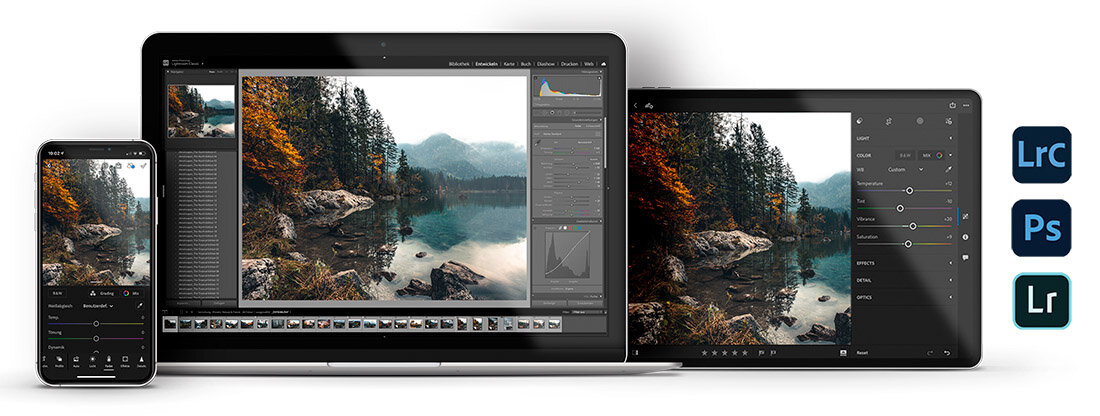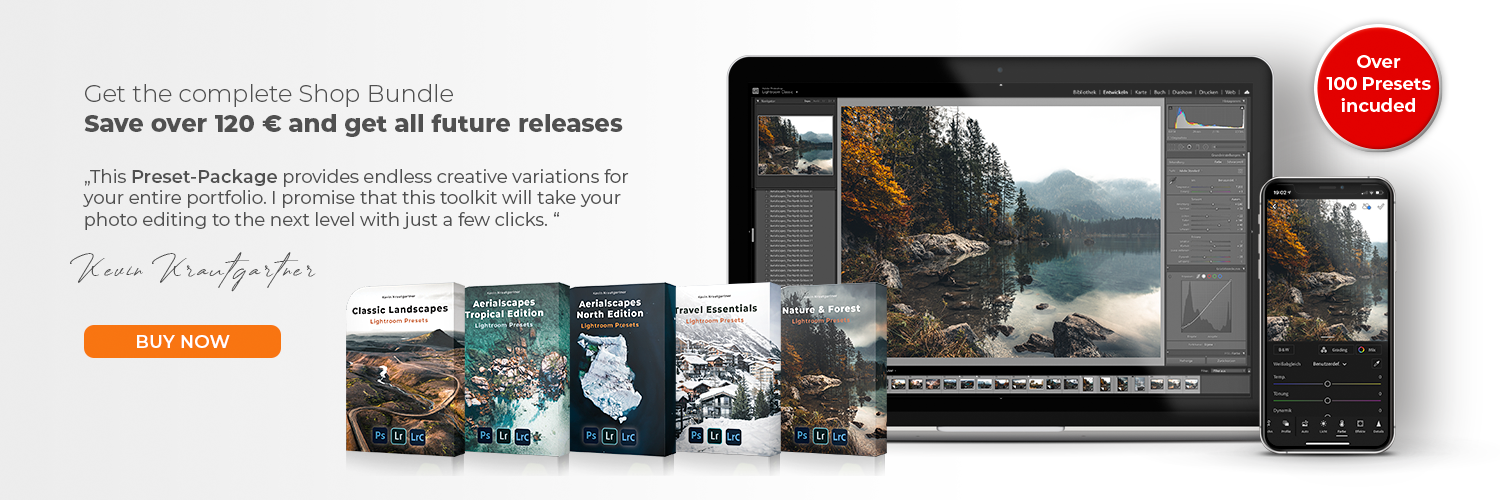How to Install Lightroom Presets in 2025
Installing Presets to your Adobe Lightroom application will only take a few minutes.
Due to the „Import Presets“ button in the newer versions of Lightroom you will only need the a clicks.
All my free and premium presets are compatible with Lightroom, Lightroom Classic and the Lightroom Mobile app which is completely free.
If you are using older versions of Lightroom like 4, 5 or 6, you can also install my presets as I offer .lrtemplate preset files in addition to the actual .xmp file format.
As the process of installing the Presets to Lightroom, Lightroom Classic and Lightroom Mobile is different I have separate into different chapters. Just scroll to the section, or click on of the icons above, which matches your application. To get started you should have already downloaded and extracted the .zip file onto your device.
Installing presets in Lightroom Classic (version 7.3 or later) on Mac or Windows
The following instructions will guide you through the installation for Adobe Lightroom Classic version 7.3 or later which is using the .xmp file format. For all older versions please see instructions below.
Download your purchased Lightroom Presets which will come in a .zip file “(for current and all Lightroom versions since April 2018)”.
Start Lightroom, navigate to the Develop Module and click on File -> Import and Develop Profiles and Presets in the head menu.
Navigate to the Presets folder and pick the .zip file. You can also pick already unzipped .xmp files.
Now all Presets are ready to be used. You find them in the Presets section on the left.
Installing presets in Lightroom 4, 5, 6 and Lightroom Classic (version 7.2 or older) on Mac or Windows
This instruction will guide you through the Presets installation process for Lightroom 4, 5, 6 and Lightroom Classic (version 7.2 or older) which are using the .lrtemplate files instead of the newer .xmp files.
Download your purchased Lightroom Presets which will come in a .zip file “(for Lightroom Version 4-6 and Classic CC)”. Unzip them.
Start Lightroom. If you are a Windows user click on Edit -> Preferences in the head menu. Using a Mac you have to click Lightroom -> Preferences in the head menu.
Click on the Presets tab in the new opened window.
Click on the button named: Show Lightroom Presets Folder (older versions) or Show All Other Lightroom Presets (newer versions).
Navigate to the Develop Presets folder which you will find in the Lightroom folder.
Now you have to copy the downloaded and unzipped .lrtemplate files in the Develop Presets folder.
Restart Lightroom and all Presets are ready to be used. You find them in the Presets section on the left.
Installing presets in Lightroom CC on Mac or Windows
This instruction will guide you through the Presets installation process for Lightroom CC
Download your purchased Lightroom Presets which will come in a .zip file “(for current and all Lightroom versions since April 2018)”
Start Lightroom CC and select an image.
Click on File -> Import Profiles and Presets in the head menu.
Navigate to the Presets folder and pick the .zip file. You can also pick already unzipped .xmp files.
Now all Presets are ready to be used. Just open the Presets Panel on the right side and click on a Preset to apply it.
Installing presets in Lightroom Mobile
There are two methods of installing the Lightroom Presets onto your mobile device application. Method 1 is highly recommended as it is the easiest and fastest way to get all Presets running. If you do not have a Adobe Creative Cloud subscription you need to go for method 2 which will take slightly longer.
Method 1
You need to install all Presets in the Lightroom desktop application first. Please read the detailed instruction above. It is important that you use the Lightroom CC and not the Lightroom Classic application. After installing all Presets they will automatically be synced to your mobile device via cloud. You find a step-by-step guide here.
Method 2
The following instruction will guide you through the installation process for the free Lightroom mobile app for iOS and android without the usage of the Lightroom desktop app. If you have a Adobe Creative Cloud subscription plan method 1 is highly recommended as it works a lot faster and easier.
Installation Guide for Lightroom Mobile on Android devices
After downloading the product onto your desktop computer you need to transfer the “mobile-presets_andriod…“ ZIP onto your device.
Start your Lightroom application and select an image from your library.
Go down to the Botton of the toolbar and press the Presets tab to the right.
Press the three dots icon and select Import Presets.
Now you have to navigate to the folder where you downloaded the ZIP file and import it. You can also extract the ZIP file by using the „My Files“ app and import only selected files of the content.
All Presets are imported and ready to use. You find them in a new group in the Presets tab.
Installation Guide for Lightroom Mobile on iPhone / iOS devices
After downloading the product onto your desktop computer you need to extract the „mobile-presets_iphone…“ ZIP file and transfer all .dng files to your device. Doing this via AirDrop is highly recommended as it is the fastest way.
Start the Lightroom app on your iPhone and press the “+“ icon in your library to create a new “Folder“. You may name this folder “Presets“ and open it. Then press “Create New Album“ and name the album after the Presets you downloaded.
Once you are in the album press the “Add“ icon to import new images. Now you need to navigate to the folder where you transferred the .dng files and select + “Open“ all of them.
Open the first image and press “Create Preset“ in the menu after pressing the three dots on the top right.
Name the Preset after the Preset-Pack and save it to the Presets group.
Repeat the last two steps with every single .dng file (image) until you got all Presets listed in the Presets panel.






